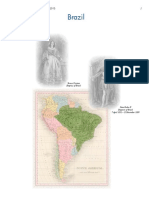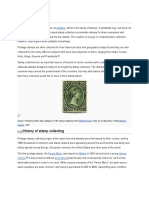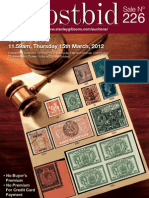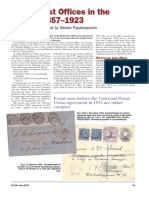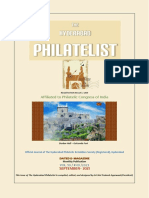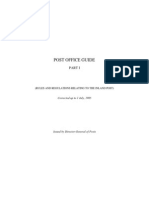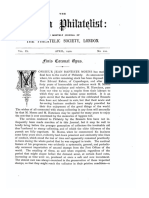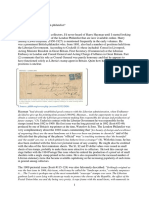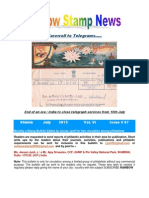0 ratings0% found this document useful (0 votes)
1K viewsAn Introduction To Advanced Philately by Sefi
An Introduction To Advanced Philately by Sefi
Uploaded by
Abhishek BhuwalkaOn the famous introductory book on philately. Published as "Reviewing a Classic: An Introduction to Advanced Philately, by Alexander Joseph Sefi" Philatelic Literature Review 66 no. 3 (Third Quarter 2017). See philaliterature.com.
Copyright:
© All Rights Reserved
Available Formats
Download as PDF, TXT or read online from Scribd
An Introduction To Advanced Philately by Sefi
An Introduction To Advanced Philately by Sefi
Uploaded by
Abhishek Bhuwalka0 ratings0% found this document useful (0 votes)
1K views3 pagesOn the famous introductory book on philately. Published as "Reviewing a Classic: An Introduction to Advanced Philately, by Alexander Joseph Sefi" Philatelic Literature Review 66 no. 3 (Third Quarter 2017). See philaliterature.com.
Original Title
An Introduction to Advanced Philately by Sefi
Copyright
© © All Rights Reserved
Available Formats
PDF, TXT or read online from Scribd
Share this document
Did you find this document useful?
Is this content inappropriate?
On the famous introductory book on philately. Published as "Reviewing a Classic: An Introduction to Advanced Philately, by Alexander Joseph Sefi" Philatelic Literature Review 66 no. 3 (Third Quarter 2017). See philaliterature.com.
Copyright:
© All Rights Reserved
Available Formats
Download as PDF, TXT or read online from Scribd
Download as pdf or txt
0 ratings0% found this document useful (0 votes)
1K views3 pagesAn Introduction To Advanced Philately by Sefi
An Introduction To Advanced Philately by Sefi
Uploaded by
Abhishek BhuwalkaOn the famous introductory book on philately. Published as "Reviewing a Classic: An Introduction to Advanced Philately, by Alexander Joseph Sefi" Philatelic Literature Review 66 no. 3 (Third Quarter 2017). See philaliterature.com.
Copyright:
© All Rights Reserved
Available Formats
Download as PDF, TXT or read online from Scribd
Download as pdf or txt
You are on page 1of 3
An
Introduction to Advanced Philately
- Alexander Joseph Sefi
While going through Vol. 30 No. 3 (3rd lithography, and surface printing in the
Quarter 1981) of Philatelic Literature first edition and additionally
Review I came across the noted photogravure in the second) and how
bibliophile William Hagan’s regular these processes affects its appearance
column Philatelic Literature Price Trends; and what abnormalities could occur
this particular issue’s column deals with, during the manufacture of the printing
amongst other things, A.J. Sefi’s surface, or during the actual printing of
masterpiece An Introduction to Advanced the stamp.
Philately. 1 Hagan describes the first
edition as well as the “Ordinary” second The first edition of Sefi’s book was
edition; but since he did not have access published in 1926; it was printed on
to the ‘De Luxe’ version of the second handmade paper and was a limited
edition he does not cover it. He ends his edition of two hundred and fifty copies2.
piece saying, “If someone will lend or sell Hagan mentions that he has not seen the
me this edition I’ll describe it.” dust jacket for this edition and nor have I;
it is possible that it was not issued with
Being fortunate in possessing a copy of one. The second edition, published 1932,
the ‘De Luxe’ edition, I will, in this article, was printed in both an ordinary edition of
describe it. However before doing so, I three hundred and fifty copies as well as
would like to give a brief background of a deluxe edition of fifty copies, the former
this book especially to readers who do printed on machine and the latter on
not have access to Sefi’s book. handmade paper. Both editions are
accompanied by a dust jacket.
The title of the book can be a bit
misleading especially if one expects the
book to erudite on stamp collecting and
its processes, famous stamps etc. Rather
the author adopts the method of
“…explaining and illustrating the
characteristics of stamps produced by
different processes”. He takes one single
design and shows how it is reproduced by
different processes (line engraving,
2 Brian J. Birch mentions in his Bibliography of
1 The full title of the book is An Introduction to General Literature in the Philatelic Library of Brian
Advanced Philately: With Special Reference to J. Birch that of the 250 copies, 240 were
Typical Methods of Stamp Production. numbered.
Description of the Deluxe Edition
If I have to stick to Hagan’s original style,
I would describe the deluxe edition as
follows:
SEFI (A.J.). An Introduction to Advanced
Philately. Rowley & Rowley Limited.
MCMXXXII. London. Quarto, 10¼ in.3,
XX + 130 pp. (4). Twenty-one plates
covered with bound-in rice paper, six
paper samples. Gilt top and deckle
fore-edge and bottom. Half leather
brown cover with brown cloth.4 Spine
has title, author, and “Second Edition”
gold stamped. Brown dust jacket
printed in black and red with the title
itself, the city, and publication date in
red; the subtitle, the author and his
credential 5 , “Second Edition”, the
publisher’s ornament, and the
publisher printed in black. Spine of
the dust jacket has the title, author
and his credential, “Price 50/- Nett
(De Luxe Edition)”, and publisher
printed in black6. Title page is similar
to the front of the dust jacket. Each
chapter has the first letter printed in annotated bibliography) would be as
red as well. A limited edition of four follows:
hundred copies so stated and then
hand numbered below.7 Autographed Sefi, Alexander J. An Introduction to
by the author signing as “A.J. Sefi” Advanced Philately: With Special
below the numbering. Reference to Typical Methods of Stamp
Production. 2nd ed. London: Rowley &
A more modern bibliography (using the Rowley Limited, 1932
Chicago Manual of Style 16th edition, (2) + xvi + (4) + 130 + (1) pp + (3) p, (21)
plates and (6) paper samples bound
3 Hagan measures the ordinary edition at 9¾ in.
in. Erratum slip bound in after page 4.
4 The cloth is in a slightly lighter shade of brown
266 x 200 mm. Hard Bound in Half
than the leather. The covers are plain.
5 “Editor of the Philatelic Journal of Great Britain” Brown Leather and Brown Cloth with
6 The dust jackets of the two editions are quite gilt lettering on spine. Gilt top edge
similar to each other excepting that the spine of and deckle fore-edge and bottom. DJ.
the dust jacket of the ordinary edition has “18/-” De luxe edition of 50 copies numbered
(shillings) printed. 351 to 400 this being 364/400.
7 The exact wording is “This is the Second Edition,
limited to four hundred copies, of which three Printed on ‘Millbourn’ Hand-Made
hundred and fifty (numbered 1 to 350) constitute paper. Signed by author on the page
the ordinary edition and fifty (printed on facing the title page. Price 50/-
“Millbourn” Hand-Made paper and numbered 351 (shillings) on DJ spine.
to 400) the “de luxe” edition”. My copy is
numbered 364.
Valuation
Before estimating the valuation of the
different editions, I would like to mention
that my estimates are based on recent
auction estimates as well as prices quoted
by various philatelic literature dealers
from time to time.
The first edition (without the dust jacket)
is typically available for between US$150
and US$250. For example, in the 352nd
Heinrich Köhler sale held on 3 Nov 2012,
lot #9304 (numbered 203/250) bought
€150 (approx. US$190) + buyers
premium.
The second ordinary edition would likely
cost US$150 to US$250. However, in the
364th Heinrich Köhler auction held on 21
Mar 2017, lot #10021 (numbered
101/350) (which also contained the first
edition of Stanley Phillips’ Stamp
Collecting) bought a surprisingly high
€620 (approximately US$680) plus
buyer’s premium. I say surprisingly since,
as I write this, I know at least two dealers
offering this book for US$180 and US$250
respectively.
Finally, the second deluxe edition is
relatively rare and I am unable to readily
find it in recent literature auctions. Given
the limited printing a copy can come up
for sale only once in a few years and on
such occasions it would be the desirous
buyer who would set its true worth.
Nevertheless I would take it to be worth
at least between US$350 to US$500, if not
more.
You might also like
- Ceylon Stamps 1948 - 1972Document10 pagesCeylon Stamps 1948 - 1972KumaraNo ratings yet
- Pierron Commonwealth Stamp Errors SaleDocument200 pagesPierron Commonwealth Stamp Errors Saledonaldduck23No ratings yet
- 13190a PDFDocument401 pages13190a PDFClaudius100% (1)
- 1996 The Postal Markings of Tibet by Hellrigl S PDFDocument69 pages1996 The Postal Markings of Tibet by Hellrigl S PDFKallimachosNo ratings yet
- Postal Stationery of Russia and Its Dependencies (1845 - 1922)Document25 pagesPostal Stationery of Russia and Its Dependencies (1845 - 1922)VDC LucienNo ratings yet
- Stamp Magazine 2022 12Document84 pagesStamp Magazine 2022 12Roland Correa50% (2)
- Indian Foreign Postal Rates 1957-2019Document33 pagesIndian Foreign Postal Rates 1957-2019Abhishek Bhuwalka100% (1)
- Fundamentals of Philately - Authors' BindingDocument4 pagesFundamentals of Philately - Authors' BindingAbhishek BhuwalkaNo ratings yet
- 2018 04 01+stamp PDFDocument132 pages2018 04 01+stamp PDFClaudiusNo ratings yet
- Stamp Catalog Norway Revenue Stamps PDFDocument1,090 pagesStamp Catalog Norway Revenue Stamps PDFCira CiricNo ratings yet
- Collecting United States Bureau Precancels - Curtis E. Gidding (ENG)Document24 pagesCollecting United States Bureau Precancels - Curtis E. Gidding (ENG)Rubens BuladNo ratings yet
- Gibbons Stamp Monthly 2008.12Document79 pagesGibbons Stamp Monthly 2008.12gebikimame100% (3)
- Stamps of The Chinese Empire DragonsDocument4 pagesStamps of The Chinese Empire DragonsMorg KorgenNo ratings yet
- Commonwealth British Empire Stamps 1840 1952 2007 Ed PDFDocument2 pagesCommonwealth British Empire Stamps 1840 1952 2007 Ed PDFJody0% (3)
- Interview With Brian J. Birch, Philatelic BibliophileDocument16 pagesInterview With Brian J. Birch, Philatelic BibliophileAbhishek Bhuwalka100% (1)
- Hayes Hayes' Auctions and Their IndexDocument10 pagesHayes Hayes' Auctions and Their IndexAbhishek BhuwalkaNo ratings yet
- USPS OIG Audit Report - Modes of DeliveryDocument34 pagesUSPS OIG Audit Report - Modes of DeliverybsheehanNo ratings yet
- 10000012961Document277 pages10000012961Chapter 11 Dockets0% (1)
- First Edition of Fundamentals of PhilatelyDocument8 pagesFirst Edition of Fundamentals of PhilatelyAbhishek BhuwalkaNo ratings yet
- Presentation On Stamp CollectingDocument94 pagesPresentation On Stamp Collectinggayasesha100% (4)
- 2018-09-01 Stamp & Coin Mart PDFDocument94 pages2018-09-01 Stamp & Coin Mart PDFClaudiusNo ratings yet
- 2009 Notes No.5 Argentina 1935-51 Definitives: Postmarks, Covers, Postcards, Postal Entires, and PERFINsDocument130 pages2009 Notes No.5 Argentina 1935-51 Definitives: Postmarks, Covers, Postcards, Postal Entires, and PERFINsAntonio RubieraNo ratings yet
- German South West Africa StampsDocument17 pagesGerman South West Africa Stampsb100% (1)
- Stamps (Sellos - Timbres) - German StatesDocument10 pagesStamps (Sellos - Timbres) - German StatesrodrigojmNo ratings yet
- Stamps of BurmaDocument96 pagesStamps of BurmaLTTuangNo ratings yet
- Sellos Stamps Timbres Scott 11 - Benin To BotswanaDocument103 pagesSellos Stamps Timbres Scott 11 - Benin To BotswanaRamiro Robles100% (1)
- Stamp & Coin Mart - October 2015Document142 pagesStamp & Coin Mart - October 2015Narendra Reddy BhumaNo ratings yet
- Sellos Stamps Timbres Scott 54 - Pakistan To Papua New GuineaDocument99 pagesSellos Stamps Timbres Scott 54 - Pakistan To Papua New GuineaRamiro RoblesNo ratings yet
- 0000E (0997 - 1004 Scott 2004 - Stamps - Islas Feroe)Document8 pages0000E (0997 - 1004 Scott 2004 - Stamps - Islas Feroe)Ramiro Robles100% (1)
- Stamp Collecting Can Pay OffDocument1 pageStamp Collecting Can Pay OffThe London Free Press100% (2)
- Spink CSS33Document376 pagesSpink CSS33Mitar MiricNo ratings yet
- Stanley Gibbons Commonwealth DepartmentDocument56 pagesStanley Gibbons Commonwealth DepartmentJim LasburyNo ratings yet
- US Color ErrorDocument10 pagesUS Color ErrorlakanthNo ratings yet
- Swaziland Stamps, Postage Dues, RevenuesDocument15 pagesSwaziland Stamps, Postage Dues, RevenuesbNo ratings yet
- 178 GoeggelDocument185 pages178 GoeggelMarcelo Gil SimõesNo ratings yet
- Stamp Magazine - October 2020 PDF Download Free PDFDocument3 pagesStamp Magazine - October 2020 PDF Download Free PDFFO VCNo ratings yet
- Stamp CollectingDocument4 pagesStamp CollectingHazwan ZainalNo ratings yet
- PB226 CatalogueDocument76 pagesPB226 Catalogueomegalink123100% (1)
- Stamp Magazine 2022 09Document76 pagesStamp Magazine 2022 09Roland CorreaNo ratings yet
- ACS 48th NZ Stamp Catalogue 2025Document168 pagesACS 48th NZ Stamp Catalogue 2025Auckland City Stamps100% (4)
- 2018-07-01 Stamp Magazine PDFDocument124 pages2018-07-01 Stamp Magazine PDFClaudiusNo ratings yet
- Fine (70) Very Fine (80) SuperbDocument14 pagesFine (70) Very Fine (80) Superblakanth100% (2)
- Rosherville Philatelic Literature - Book ListDocument39 pagesRosherville Philatelic Literature - Book Listapi-517714753No ratings yet
- ACS NZ Stamps 2017Document132 pagesACS NZ Stamps 2017Auckland City Stamps100% (5)
- Stamps of India 1955-60Document11 pagesStamps of India 1955-60pooja.capricon837100% (1)
- The Stamps of Canada by Poole, Bertram William Henry, 1880-1957Document126 pagesThe Stamps of Canada by Poole, Bertram William Henry, 1880-1957Gutenberg.org50% (2)
- 177 HauptkatalogDocument433 pages177 HauptkatalogMarcelo Gil SimõesNo ratings yet
- Gibbons Stamp Monthly 2008.11Document86 pagesGibbons Stamp Monthly 2008.11gebikimameNo ratings yet
- Afrique Du Sud - Transvaal - Postal History Part 5 - Émissions BritanniquesDocument95 pagesAfrique Du Sud - Transvaal - Postal History Part 5 - Émissions BritanniquesHervé DenisNo ratings yet
- 03 - Levant - Empire Ottoman - Bureaux Britanniques - 1857-1923 - Postal History 1Document4 pages03 - Levant - Empire Ottoman - Bureaux Britanniques - 1857-1923 - Postal History 1Hervé DenisNo ratings yet
- 02c Gem Stone ValuesDocument3 pages02c Gem Stone ValuesMichael McBearNo ratings yet
- Seafall RulesDocument24 pagesSeafall RulesJeffNo ratings yet
- Revenue Stamps of India - Wikipedia, The Free Encyclopedia PDFDocument5 pagesRevenue Stamps of India - Wikipedia, The Free Encyclopedia PDFSelvaraj VillyNo ratings yet
- 16CS02 Catalogue PDFDocument27 pages16CS02 Catalogue PDFJuanjo Pinilla Ruiz100% (1)
- Stamp Magazine April 2020Document92 pagesStamp Magazine April 2020codriver69No ratings yet
- 112009W StampsDocument8 pages112009W StampsDawn KondosNo ratings yet
- Stamp & Coin Mart - January 2017Document124 pagesStamp & Coin Mart - January 2017studworxshop100% (2)
- 1049Document197 pages1049Ernesto QuissakNo ratings yet
- Forgeries of Common Stamps after World War I: Eastern Front, Balkans, CaucasusFrom EverandForgeries of Common Stamps after World War I: Eastern Front, Balkans, CaucasusNo ratings yet
- 09 Stamp Collector Setiembre 2021Document86 pages09 Stamp Collector Setiembre 2021Leonardo Daniel Leidi MoraNo ratings yet
- The Hyd Philatelist Sept 2021Document52 pagesThe Hyd Philatelist Sept 2021nsigamanyNo ratings yet
- Gibbons Stamp Monthly 2013-07 PDFDocument166 pagesGibbons Stamp Monthly 2013-07 PDFDanToledo100% (3)
- Azad Hind StampsDocument5 pagesAzad Hind StampslakanthNo ratings yet
- Bermuda: 1848-61 Postmaster Stamps HamiltonDocument59 pagesBermuda: 1848-61 Postmaster Stamps HamiltonLeonardo RedeligoNo ratings yet
- James Joyce. First Editions CatalogueDocument19 pagesJames Joyce. First Editions CataloguealdoremoNo ratings yet
- Cecil Rose and His SkullduggeriesDocument10 pagesCecil Rose and His SkullduggeriesAbhishek BhuwalkaNo ratings yet
- India's First Ship Despatch HandstampDocument4 pagesIndia's First Ship Despatch HandstampAbhishek BhuwalkaNo ratings yet
- Calumnies of Sam SingerDocument8 pagesCalumnies of Sam SingerAbhishek BhuwalkaNo ratings yet
- Ship Postage On Steam Letters 1845-46Document17 pagesShip Postage On Steam Letters 1845-46Abhishek BhuwalkaNo ratings yet
- Interview With William Hagan, Philatelic BibliophileDocument20 pagesInterview With William Hagan, Philatelic BibliophileAbhishek BhuwalkaNo ratings yet
- David Beech InterviewDocument16 pagesDavid Beech InterviewAbhishek BhuwalkaNo ratings yet
- The Wreck of The Ava and The Unlucky William FarquharDocument6 pagesThe Wreck of The Ava and The Unlucky William FarquharAbhishek BhuwalkaNo ratings yet
- India Officers' LettersDocument12 pagesIndia Officers' LettersAbhishek BhuwalkaNo ratings yet
- Indian Inland Postal Rates 1957-2019Document14 pagesIndian Inland Postal Rates 1957-2019Abhishek BhuwalkaNo ratings yet
- 1830 Bengal Rates - Date of IntroductionDocument4 pages1830 Bengal Rates - Date of IntroductionAbhishek BhuwalkaNo ratings yet
- The Wreck of The SS Ava (1858) - Presentation To India Study CircleDocument33 pagesThe Wreck of The SS Ava (1858) - Presentation To India Study CircleAbhishek BhuwalkaNo ratings yet
- Interview With Phil Bansner, Philatelic Literature DealerDocument10 pagesInterview With Phil Bansner, Philatelic Literature DealerAbhishek BhuwalkaNo ratings yet
- Interview With Leonard Hartmann, Philatelic Literature DealerDocument14 pagesInterview With Leonard Hartmann, Philatelic Literature DealerAbhishek BhuwalkaNo ratings yet
- London Philatelist - Temporary EditorsDocument3 pagesLondon Philatelist - Temporary EditorsAbhishek BhuwalkaNo ratings yet
- The Wreck of The P&O AVA (1858)Document38 pagesThe Wreck of The P&O AVA (1858)Abhishek BhuwalkaNo ratings yet
- Interview With Burkhard Schneider, Philatelic Literature DealerDocument18 pagesInterview With Burkhard Schneider, Philatelic Literature DealerAbhishek BhuwalkaNo ratings yet
- Advertisement and Other Supplements To The Journal and Publications of The Philatelic Literature SocietyDocument16 pagesAdvertisement and Other Supplements To The Journal and Publications of The Philatelic Literature SocietyAbhishek BhuwalkaNo ratings yet
- Interview With David Druett, Philatelic Literature DealerDocument10 pagesInterview With David Druett, Philatelic Literature DealerAbhishek BhuwalkaNo ratings yet
- Interview With Casper Pottle, Philatelic Literature DealerDocument8 pagesInterview With Casper Pottle, Philatelic Literature DealerAbhishek BhuwalkaNo ratings yet
- Philatelic Literature Society (JPLS) Saw Better-Than-Usual Response This Has Motivated Me ToDocument8 pagesPhilatelic Literature Society (JPLS) Saw Better-Than-Usual Response This Has Motivated Me ToAbhishek BhuwalkaNo ratings yet
- The Journal of The Philatelic Literature Society and Its SupplementsDocument37 pagesThe Journal of The Philatelic Literature Society and Its SupplementsAbhishek BhuwalkaNo ratings yet
- Philatelic Literature: Decoding Whats's Out ThereDocument35 pagesPhilatelic Literature: Decoding Whats's Out ThereAbhishek BhuwalkaNo ratings yet
- Library of The Royal Philatelic Society of VictoriaDocument6 pagesLibrary of The Royal Philatelic Society of VictoriaAbhishek BhuwalkaNo ratings yet
- Early Indian Philatelic Literature 1875-1900Document41 pagesEarly Indian Philatelic Literature 1875-1900Abhishek BhuwalkaNo ratings yet
- Early Indian Philatelists & DealersDocument27 pagesEarly Indian Philatelists & DealersAbhishek Bhuwalka100% (1)
- 6 - Postal Glossary Part IIDocument55 pages6 - Postal Glossary Part IIUma MaheswararaoNo ratings yet
- 2010 Commit AlphaDocument251 pages2010 Commit AlphaJoe CoffeyNo ratings yet
- Po Guide Part - 1Document172 pagesPo Guide Part - 1K V Sridharan General Secretary P3 NFPE71% (7)
- HKPost Pos15 EngDocument20 pagesHKPost Pos15 EngVekMuddleNo ratings yet
- USPS Nondenominated Postage Values PDFDocument4 pagesUSPS Nondenominated Postage Values PDFchopin_onionsNo ratings yet
- T-N - U1 - L2 - IPA The Postage StampDocument2 pagesT-N - U1 - L2 - IPA The Postage StampTeacher Huong'sNo ratings yet
- Baronial Envelope Sizes Triangular FlapDocument1 pageBaronial Envelope Sizes Triangular FlapTriccia Leah Lanzaderas-VelascoNo ratings yet
- London Philatelist: The Philatelic Society, LondonDocument24 pagesLondon Philatelist: The Philatelic Society, LondonVIORELNo ratings yet
- Cochin PagesDocument50 pagesCochin PagesSayidNo ratings yet
- Active DataDocument352 pagesActive DataTehmina HanifNo ratings yet
- Stamp & Coin Mart - January 2017Document124 pagesStamp & Coin Mart - January 2017studworxshop100% (2)
- Premium Home Delivery PincodesDocument26 pagesPremium Home Delivery PincodesAsha BhambhaniNo ratings yet
- London Philatelist:: Past and FutureDocument30 pagesLondon Philatelist:: Past and FutureVIORELNo ratings yet
- Sudan2017 95p StampsbookscomDocument95 pagesSudan2017 95p StampsbookscomAmmar ElmubarakNo ratings yet
- Third Party Affidavit of Mailing: Cut Along Dotted LineDocument2 pagesThird Party Affidavit of Mailing: Cut Along Dotted LinebiscuitheadNo ratings yet
- Stamp InventoryDocument29 pagesStamp Inventoryapi-231084212No ratings yet
- Catalog of The: North American Library of The India Study CircleDocument105 pagesCatalog of The: North American Library of The India Study CircleRabirashmi RoyNo ratings yet
- DAGA IRS Yr-End 2017Document143 pagesDAGA IRS Yr-End 2017paul weichNo ratings yet
- West BengalDocument180 pagesWest BengalRishi WadhwaniNo ratings yet
- Akhtar Ul Islam Siddiqui - A Legend in Philately: by Dr. Muhammad Ashraf ChoudhryDocument3 pagesAkhtar Ul Islam Siddiqui - A Legend in Philately: by Dr. Muhammad Ashraf ChoudhryTechnical and prolem-solving MasterNo ratings yet
- London Philatelist:: Finis Coronat OpusDocument30 pagesLondon Philatelist:: Finis Coronat OpusVIORELNo ratings yet
- H.L. Hayman: The Forgotten Philatelist?Document4 pagesH.L. Hayman: The Forgotten Philatelist?MikNo ratings yet
- July Rainbow 2013Document45 pagesJuly Rainbow 2013Jeevan JyotiNo ratings yet
- Dhai Akhar letterwriting ..Document3 pagesDhai Akhar letterwriting ..thressiammamathew1953No ratings yet
- Hurricane Ian Zip CodesDocument15 pagesHurricane Ian Zip CodesDrk WbNo ratings yet
- Solucionario Design of Reinforced Concrete 8th Ed by Mccormac Brown Part1 PDFDocument228 pagesSolucionario Design of Reinforced Concrete 8th Ed by Mccormac Brown Part1 PDFAngie BecerraNo ratings yet
- Enteros Postales NicaraguaDocument16 pagesEnteros Postales NicaragualuluemirmaoNo ratings yet


































